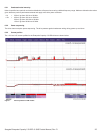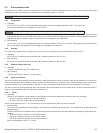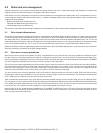
Seagate Enterprise Capacity 2.5 HDD v3 SAS Product Manual, Rev. D 28
6.5 Environmental limits
Temperature and humidity values experienced by the drive must be such that condensation does not occur on any drive part. Altitude and
atmospheric pressure specifications are referenced to a standard day at 58.7°F (14.8°C).
6.5.1 Temperature
a. Operating
41°F to 131°F (5°C to 55°C) drive temperature range with a maximum temperature gradient of 36°F (20°C) per hour.
The maximum allowable drive temperature is 140°F (60°C).
Air flow may be required to achieve consistent nominal drive temperature values (see Section 9.2). To confirm that the required cooling
is provided for the electronics and HDA, place the drive in its final mechanical configuration, and perform random write/read operations.
After the temperatures stabilize, read drive temperature from Temperature Log Page (0Dh).
b. Non-operating
–40° to 158°F (–40° to 70°C) package ambient with a maximum gradient of 36°F (20°C) per hour. This specification assumes that the
drive is packaged in the shipping container designed by Seagate for use with drive.
6.5.2 Humidity
The values below assume that no condensation on the drive occurs. Maximum wet bulb temperature is 84.2°F (29°C).
a. Operating
5% to 95% non-condensing relative humidity with a maximum gradient of 20% per hour.
b. Non-operating
5% to 95% non-condensing relative humidity with a maximum gradient of 20% per hour.
6.5.3 Effective altitude (sea level)
a. Operating
–1000 to +10,000 feet (–304.8 to +3048 meters)
b. Non-operating
–1000 to +40,000 feet (–304.8 to +12,192 meters)
6.5.4 Shock and vibration
Shock and vibration limits specified in this document are measured directly on the drive chassis. If the drive is installed in an enclosure to
which the stated shock and/or vibration criteria is applied, resonances may occur internally to the enclosure resulting in drive movement in
excess of the stated limits. If this situation is apparent, it may be necessary to modify the enclosure to minimize drive movement.
The limits of shock and vibration defined within this document are specified with the drive mounted by any of the four methods shown in
Figure 5, and in accordance with the restrictions of Section 10.3.
6.5.4.1 Shock
a. Operating
The drive, as installed for normal operation, shall operate error free while subjected to intermittent shock not exceeding:
• 40 Gs at a maximum duration of 11ms (half sinewave)
• 25 Gs at a maximum duration of 2ms (half sinewave)
Shock may be applied in the X, Y, or Z axis. Shock is not to be repeated more than once every 2 seconds.
b. Non-operating
The limits of non-operating shock shall apply to all conditions of handling and transportation. This includes both isolated drives and
integrated drives.
The drive subjected to nonrepetitive shock not exceeding the three values below, shall not exhibit device damage or performance deg-
radation.
• 80 Gs at a maximum duration of 11ms (half sinewave)
• 400 Gs at a maximum duration of 2ms (half sinewave)
• 300 Gs at a maximum duration of 0.5ms (half sinewave)
Shock may be applied in the X, Y, or Z axis.
Note
To maintain optimal performance drives should be run at nominal drive temperature and humidity.
Note
Operating drive temperature references temperature reported by the drive on Log Page 0Dh


















